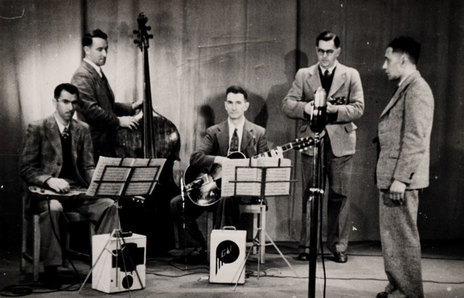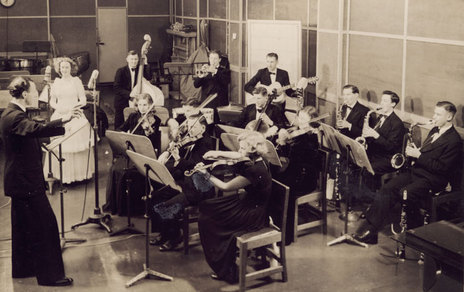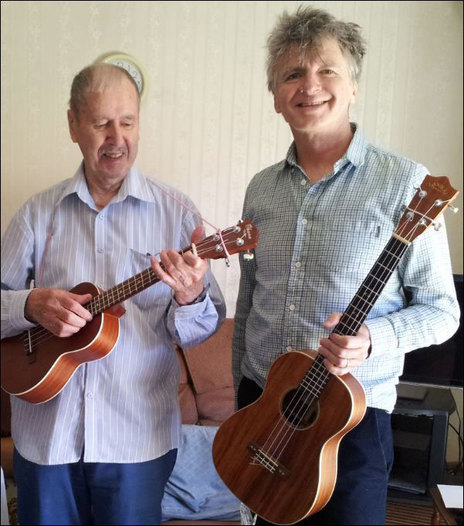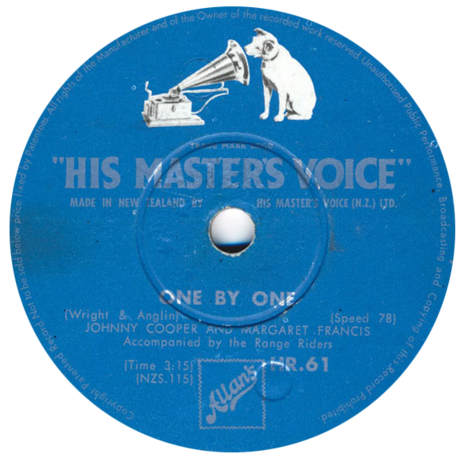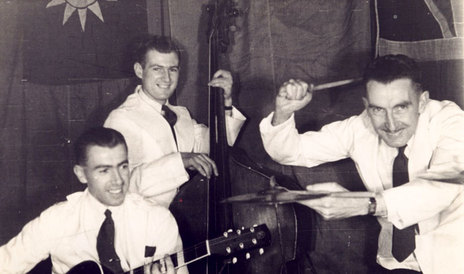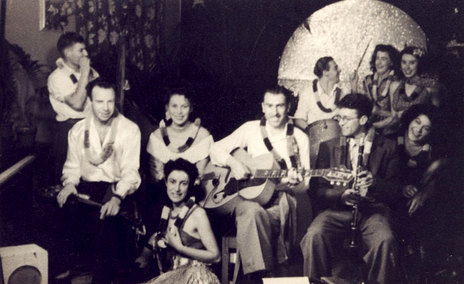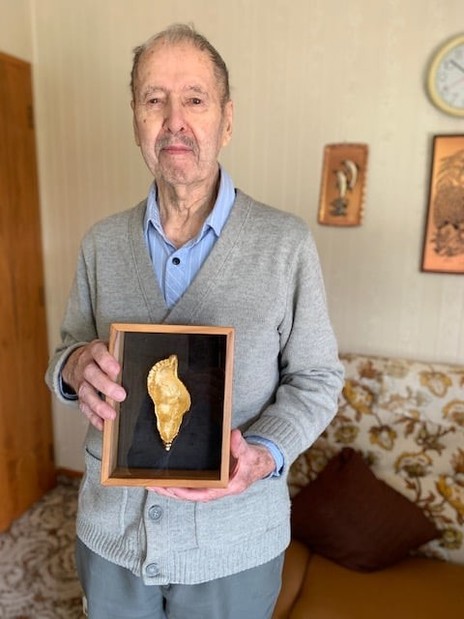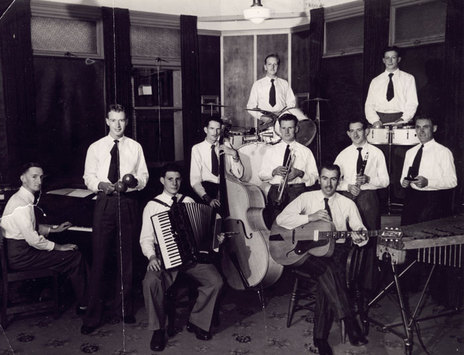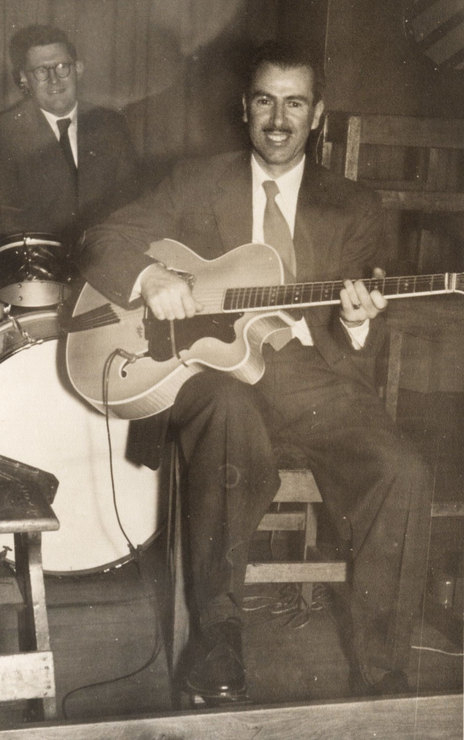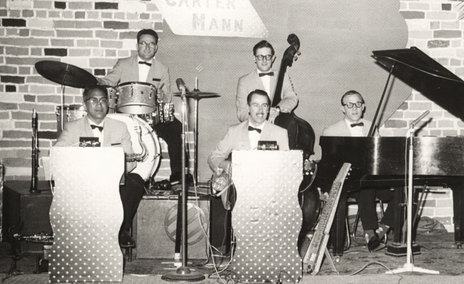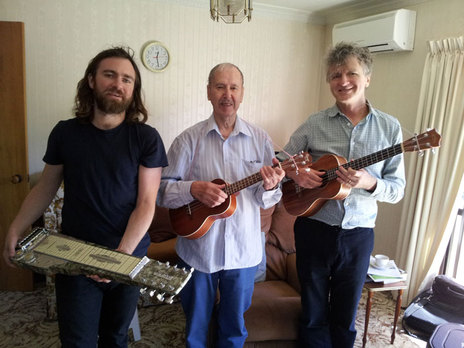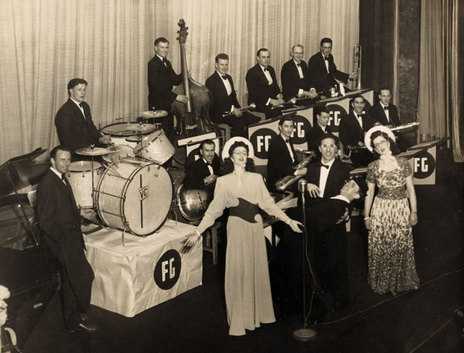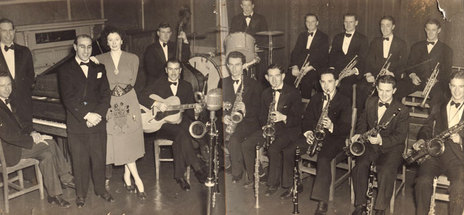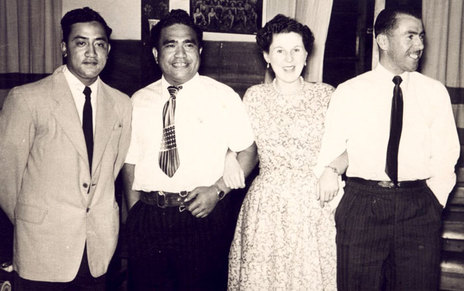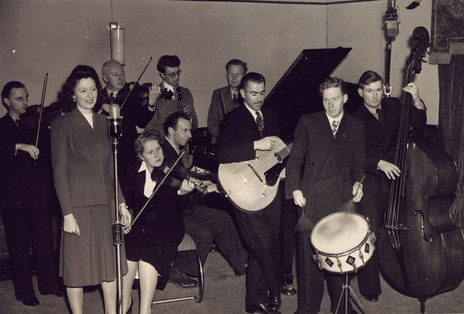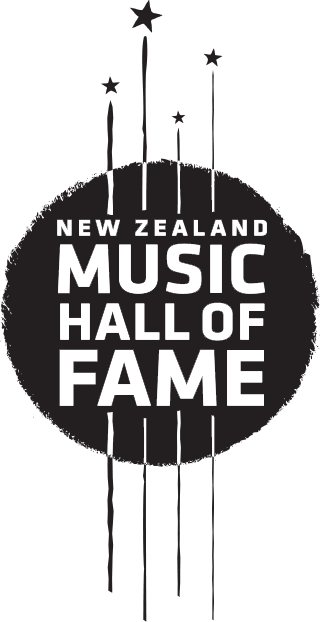Sixty-seven years later, in 2015 Carter revisited the song in collaboration with Neil Finn, when the latter was asked for a recording to mark the centenary of Anzac Day. ‘Blue Smoke’ has always been associated with the Second World War, and to Finn it was an opportunity to pay tribute to the soldiers of his father’s generation – and the musicians.
Jim Carter’s contribution to New Zealand’s pop music history didn’t stop at ‘Blue Smoke’.
Jim Carter’s contribution to New Zealand’s pop music history didn’t stop at ‘Blue Smoke’. In the same year, he played rhythm guitar on Tanza #2, Ken Avery’s ‘Paekakariki’, and in the mid-1950s he played on several pivotal recordings by Johnny Cooper: his biggest hit ‘One By One’, his originals ‘Look What You Done (Lonely Blues)’ and ‘Pie-Cart Rock’n’Roll’, and his version of ‘Rock Around the Clock’.
By then, the vogue for steel-guitar players had faded in favour of electric guitars. “I quite liked rock’n’roll,” Carter said in 2008. “The only trouble was it killed the Hawaiian style. It was too gentle.”
Carter first picked up the lap-steel guitar in 1936, when he was 17. He was then living in Lower Hutt, where he grew up after emigrating from Britain at the age of five. Also in 1936 he saw his first electric guitar, a Gibson. “It was beautiful, but it cost about a year’s salary. So I could only dream.”
He aspired to be a dance band guitarist, so took lessons on rhythm guitar and joined a band called Gerry Hall and his Orchestra, playing in a church opposite the Basin Reserve. Hall was a drummer whose kit “had every gadget imaginable – a ship’s whistle, ordinary whistle, everything”. Ten years later, Hall would play rhythm guitar in Carter’s combo that recorded ‘Blue Smoke’.)
Carter went to night school to study radio technology so that he could build his own amplifier; by day he worked for the Post Office, a career that lasted nearly 40 years. During the Second World War, he was in the army for a year, but tuberculosis kept him away from the action; instead, he worked as an army chef and often performed at concerts held in military camps such as Trentham. After the war, the dance band scene was booming, with regular dances taking place in halls around the country. ‘But there were only about six guitarists in town, so a friend suggested I audition for the 2YA Orchestra,” said Carter.
Each week on what is now Radio NZ National – broadcasting live-to-air from a Wellington studio on a powerful transmitter – the 2YA Orchestra played “pop music of the day”, accompanying a female vocalist live-to-air. The band leader was an expatriate Canadian saxophonist, Art Rosoman, who could write arrangements without consulting an instrument. “It was terrific for me because all the rest of the orchestra were really good musicians, the best in Wellington,” recalled Carter. “And I was probably the worst. So to sit in with them was terrific.” Among the musicians were Alex Lindsay, later first violinist of the New Zealand Symphony Orchestra, and Bill Hoffmeister, a legendary man-about-town who played several instruments, was an accomplished water colourist and dedicated weightlifter.
In the 2YA Orchestra, Carter played rhythm on a Spanish acoustic guitar. “I was never a jazz person,” he said. “The only thing I was doing was playing basic chords. That was the bottom line you had to play: to be able to play chords in every basic key.”
Carter’s regular gig in the late 1940s and early 1950s was playing at the Ngāti Pōneke Club, a gathering place for Māori who had migrated to Wellington. It was a big hall near the railway station, with a ceiling completely covered by a Union Jack flag made out of crepe paper. Most of audience and dancers were Māori, and the venue was strictly but benevolently run by Fred Katene. He would wander about with a hoe in his hand to scrape chewing gum off the dance floor, and keep an eye on any potential trouble. “One night a couple of seamen came in and they were starting to act up a bit, and Fred came and said, ‘You boys will have to go.’ They said, ‘Try and make us’. Immediately, about three big Māori came up, all about six foot six and they just took them by the arms and shoulders out of the club. No trouble. One of the Māori bouncers was about two metres tall and about a metre wide. Someone’s car had a puncture one night and he just lifted the front end.”
At Ngāti Pōneke, Carter was on rhythm guitar as the band had a virtuoso lap-steel player, Mati Hita. “Mati was an amazing steel guitarist, he played anything and everything, and he never even had to look where he was going. He could carry on a conversation while he was playing. And he used to play the Gay Gordons [an “old-time” dance] and sometimes go on for 20 minutes, round and round, with two big rings of dancing couples. He’d get faster and faster until they were just about worn out. He was terrific.” Hita was the best in New Zealand, says Carter, but he was rather disorganised so never had the career of more savvy players such as Bill Wolfgramm and Bill Sevesi.
Ruru Karaitiana, the composer of ‘Blue Smoke’, was leading a dance band in Wellington in the late 1940s, and asked Carter to sit in with them.
Ruru Karaitiana, the composer of ‘Blue Smoke’, was leading a dance band in Wellington in the late 1940s, and asked Carter to sit in with them. "Then whenever he was rounding musicians up for a gig he’d come and get me. When he got this record contract he wanted a Hawaiian quartet so he came to me and said, what about your band doing it? So I was quite happy to do that.”
On ‘Blue Smoke’ – recorded in Tanza’s new studio at 262 Wakefield Street, Wellington – Carter played a six-string lap-steel guitar that had a pickup made locally by His Master’s Voice. (The British-owned record company also had a division that made everything from radios to toasters.) The song was released nine months after it was recorded. By that time, there was no opportunity to perform it live, as the singer Pixie Williams and Karaitiana had both left Wellington.
In 1955 Carter was involved in several other pioneering recordings when he was asked to play guitar and lap steel for Johnny Cooper, the “Māori Cowboy”. These sessions at Sonic Studios in Island Bay were Cooper’s early recordings, before he was told to record ‘Rock Around the Clock’ by HMV. Almost all were country music, and ‘One By One’ – originally recorded by Kitty Wells – was a hit. But the B-side, an original by Cooper called ‘Look What You Done (Lonely Blues)’, became a perennial singalong throughout the country. Cooper’s easy-going strum became widely imitated.
Cooper’s cover of ‘Rock Around the Clock’ – New Zealand’s first rock’n’roll recording – has been retrospectively maligned for not being rock’n’roll enough. The circumstances explain why: the musicians were mostly jazz players, and none of them – including Cooper – had heard rock’n’roll before. Alongside Carter on guitar, the band featured Ken Avery on saxophone (writer of ‘Tea at Te Kuiti’ and ‘Paekakariki’), Bob Barcham on piano, Doug Brewer on bass and Vern Clare on drums: all accomplished players, who were paid three guineas each.
There were also technical issues. “I never had the right equipment,” says Carter. “All my guitar stuff was too low, and I didn’t get into the high, screamy stuff.” He is prouder of the B-side, ‘Blackberry Boogie’, on which he played a short solo using his Spanish acoustic guitar fitted with an electric pickup. It was an F-hole acoustic; he had been tempted to buy a round-hole acoustic Gibson, but dance band guitarists only used F-hole guitars: “Round sound-holes were for hillbillies!” said Carter. “They wanted £5 for it and I offered £4/10 – I wouldn’t go the extra 10 bob, and never stopped kicking myself.”
Aficionados of early New Zealand rock’n’roll champion another original by Cooper as a seminal moment: ‘Pie Cart Rock’n’Roll’. While melodically the tune is generic rockabilly, its “pea, pie, pud” lyrics are quintessentially from New Zealand. The song was recorded in 1957, and besides Cooper on guitar and vocals, Carter was joined by big-band leader Don Richardson on saxophone, and Cooper’s regular bassist Will Lloyd-Jones. The confident drummer is likely to be Vern Clare. “We went down to a room near the Wellington railway station, with a mobile recording unit from HMV. I was on the Spanish, and I got a couple of solos but they’re under-recorded. You can hardly hear them.”
Carter told stories about the old days, the smoky dance halls, the difficulties of getting instruments, and of getting paid.
Carter was still performing live until the early 1970s, mostly in hotels as background music. When rock bands started appearing in pubs after the demise of six o’clock closing in 1967, the days of small combos playing discreet, Hawaiian-style instrumentals were numbered.
In 2015 Carter turned 96. Until his early 90s, he was playing lap-steel guitar every day, to keep his chops up and for his own amusement. He enjoys the luxury of watching famous steel-guitar virtuosos on YouTube, something unimaginable when he picked up the instrument nearly 80 years ago.
In February 2015 he was recruited for his first session in decades, perhaps even for over half a century. The request came not by phone but by email. Would he be prepared to play lap-steel guitar on a version of ‘Blue Smoke’ being recorded by Neil Finn? Carter was chuffed to be asked, but was reluctant. “I’ve given up the lap-steel,” he said. “My fingers no longer have the energy to press the strings down. So I’ve taken up the ukulele.”
Finn arrived at Carter’s home near Nelson with an acoustic guitar, some decent microphones and his son Liam to record the session into a laptop. Expectations were realistic: it would be a memorable encounter, whatever happened. Carter, modest about his abilities, was happy to be in the company of musicians again. The living-room session began gently, with Carter strumming along on ukulele while Neil sang ‘Blue Smoke’ and played acoustic guitar.
Throughout the meeting, Carter’s modesty came through. When Finn said that his steel-guitar part was crucial to the original recording, Carter replied, “I was never very impressed with it at the time.”
“It’s lasted pretty damn well, said Finn. “You didn’t think you played it that well?”
“I thought it was pretty ordinary.”
“As a song or as a performance?” asked Finn.
“Playing. The silly part is I can’t play as good as that now.”
Afterwards, Finn said: “Jim made us feel very welcome and it was great to talk to him about music, instruments, his influences. I think he enjoyed having a face-to-face exchange with another musician and his humility was very endearing.”
Carter told stories about the old days, the smoky dance halls, the difficulties of getting instruments, and of getting paid. He described characters such as pioneering songwriters Ken Avery, Sam Freedman and Ruru Karaitiana; musicians he performed alongside, including the bassists Doug Brewer, who had two fingers missing on one hand, and Slim Dorwood, who was virtually blind.
As the Finns were about to leave, Carter plugged his favourite lap-steel into a Fender amplifier and nonchalantly played his famous solo in ‘Blue Smoke’. Finn said later: “His guitar part was simpler and leaner than the original but still elegant and soulful.”
Carter’s touch was gentle but deft, the cicadas sang along – and the poignant song came alive again for another generation.
Four years later, on 27 March 2019, Jim Carter turned 100. Seventy years after recording ‘Blue Smoke’ and 83 years after he first picked up a lapsteel guitar, Carter still plays a ukulele to amuse himself, and checks out steel guitar heroes on YouTube. He received cards from the Queen, the Prime Ministers, several MPs – and a video serenade from Neil Finn.
--
Jim Carter died on 2 October 2022, aged 103. On hearing of his death, Finn wrote on his website: “Meeting Jim was one of the highlights of my life. To find a man so interested and engaged with life, music and people, then already in his nineties, was a huge inspiration for me. The afternoon we shared and the music we made lives on in my memory. He was simply one of the good guys and a great musical talent. Sail Away Jim – RIP.”
